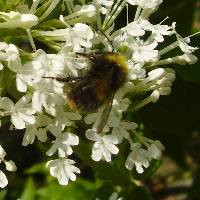



I do try to take pictures of as many bumble bees as I can see and keep a digital camera with me. As I am no expert on the different species, I live in hope that a visitor to the webpages might help identify them.
Different species can be seen at different times of the year, sometimes on the same flowers. Some prefer early in spring, others are only seen as the summer wanes. You may see some species of these hard working bees from spring to autumn and sometimes in winter on warmer days, visiting flowers, on the ground, in sheltered places such as out buildings and occasionally inside the house. They may rest on the ground especially in mid-morning as they deal with excess water (nectar provides too much for them to deal with quickly).
 If they are covered in mites, this is no problem as they are "commensals", sharing the "table" with the bees in their nests. Once the new generation of queens is ready to leave the nest, they carry mites with them until they settle in a new nesting place. They are not parasites, but rather, symbionts, cleaning up around the bee's nest, which performs a useful exchange of assistance.
If they are covered in mites, this is no problem as they are "commensals", sharing the "table" with the bees in their nests. Once the new generation of queens is ready to leave the nest, they carry mites with them until they settle in a new nesting place. They are not parasites, but rather, symbionts, cleaning up around the bee's nest, which performs a useful exchange of assistance.
Beekeepers may have more opportunities to see them, as old comb (cleaned of honey, ready for the smelter) makes an attractive smell as does new beeswax foundation in boxes ready to take to the hives.
I have not had any luck attracting bumblebees into a nesting box but I am told that if caught before they find a nesting site, may stay when put into one. Tubes and boxes including bumble bees.




mating bumblebees
Peter Edwards took this in Carbis Bay whilst on holiday in late October 2006.

For an interesting site with pictures of many bumble bees see the British Marine Life Study Society page on Bumblebees!